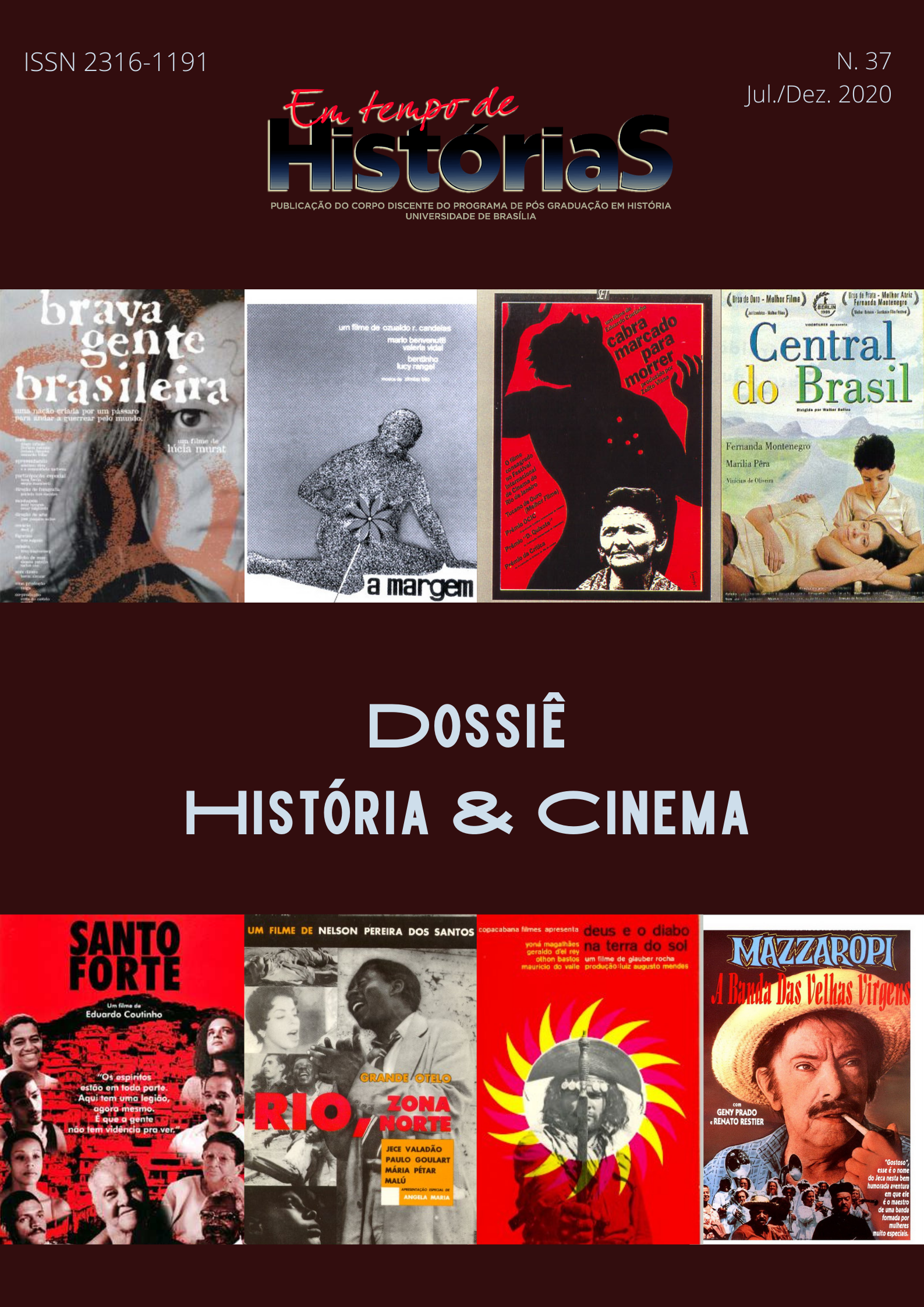Jazz as a Catalysis Element in Greek Tragedy, according to Friedrich Nietzsche, in the movie Crisis (1945) by Ingmar Bergman
DOI:
https://doi.org/10.26512/emtempos.v1i37.34169Keywords:
History and Cinema. Ingmar Bergman. Jazz and Greek Tragedy.Abstract
This paper analyses Ingmar Bergman's movie Crisis (1945), mainly focusing on the party scene as a conflict point of the narrative, during which the jazz music can be seen as the catalysis to a greek tragedy, as stated by Friedrich Nietzsche, amongst the involved characters. The hypothesis here discussed is that the Swedish filmmaker writes Jack as a dionysiac personification; and the teenage Nelly as the symbol of apollonian values. During the party, passion unites these characters in a subtle but powerful way, unleashing the plot, whereas jazz acts as the main element of the scene.
Downloads
References
ADORNO, THEODOR W.; EISLER, HANNS. El Cine y La Música. Tradução. Fernando Montes. 2ª Ed. Madrid: Editorial Fundamentos, 1981.
ARMANDO, Carlos. O Planeta Bergman. Belo Horizonte: Oficina de Livros, 1988.
BERENDT, Joachim E. O Jazz: do Rag ao Rock. São Paulo: Perspectiva, 1975. (Coleção Debates, vol. 109).
BERGMAN, Ingmar. Imagens. São Paulo: Martins Fonte, 1996.
BERGMAN, Ingmar. Lanterna Mágica. Tradução. Marion Xavier, São Paulo: Cosac Naif, 2013.
BORDWELL, David. O Cinema Clássico Hollywoodiano: Normas e Princípios Narrativos. In: RAMOS, Fernão Pessoa (Org.). Teoria contemporânea do cinema - Vol. II. São Paulo: SENAC, 2005.
CALADO, Carlos. O Jazz como Espetáculo. São Paulo: Perspectiva, 1990. (Debates; v. 236).
CHION, Michel. A Audiovisão: Som e Imagem no Cinema. Lisboa: Texto & Grafia, 2011.
CHOVE sobre o nosso amor. Direção: Ingmar Bergman. Suécia: AB Svensk Filmindustri, 1946. 95 min, sonoro, preto e branco, legendado.
CRISE. Direção: Ingmar Bergman. Suécia: AB Svensk Filmindustri, 1945. 93min., preto e branco, legendado.
FANNY e Alexander. Direção: Ingmar Bergman. Suécia: Cinematograph AB/Sveriges Television AB TV1/Gaumont International AS/Personafilm GmbH/Tobis Filmkunst GmbH/Stiftelsen Svenska Filminstitutet, 1982. 188 min., sonoro, colorido, legendado.
GUINLE, Jorge. Jazz Panorama. 3ª Ed. Rio de Janeiro: José Olympo, 2002.
HELDING, Erik. Music, lust and modernity: Jazz in the films of Ingmar Bergman. The Moving Image Review & Art Journal (MIRAJ). UK, Vol. 4, Nº 2, p. 89-99, 2011.
HOBSBAWN, Eric J. História Social do Jazz. Tradução. Angela Noronha. Rio de Janeiro: Paz e Terra, 1990.
LÓPEZ, Jordi Puigdomènech. Ingmar Bergman: El Último Existencialista. 2ª Ed. Madrid: Ediciones JC, 2007.
MÔNICA e o desejo. Direção: Ingmar Bergman. Suécia: AB Svensk Filmindustri, 1952. 96 min., sonoro, preto e branco, legendado.
MORANGOS silvestres. Direção: Ingmar Bergman. Suécia: AB Svensk Filmindustri, 1957. 95 min., sonoro, preto e branco, legendado.
MÚSICA na noite. Direção: Ingmar Bergman. Suécia: AB Svensk Filmindustri, 1948. 87 min., sonoro, preto e branco, legendado.
NIETZSCHE, Friedrich. O Nascimento da Tragédia. Tradução. Antônio Carlos Braga. São Paulo: Escala, 2013.
NOITES de circo. Direção: Ingmar Bergman. Suécia: AB Sandrew-Produktion, 1952. 93 min., sonoro, preto e branco, legendado.
O RITO. Direção: Ingmar Bergman. Suécia: Cinematograph AB, 1969. 72 min., sonoro, preto e branco, legendado.
O ROSTO. Direção: Ingmar Bergman. Suécia: AB Svensk Filmindustri, 1958. 100 min., sonoro, preto e branco, legendado.
O SÉTIMO selo. Direção: Ingmar Bergman. Suécia: AB Svensk Filmindustri, 1956. 96 min., sonoro, preto e branco, legendado.
O SILÊNCIO. Direção: Ingmar Bergman. Suécia: AB Svensk Filmindustri, 1963. 81 min., sonoro, preto e branco, legendado.
PERSONA. Direção: Ingmar Bergman. Suécia: AB Svensk Filmindustri, 1966. 85 min., sonoro, preto e branco, legendado.
PORTO. Direção: Ingmar Bergman. Suécia: AB Svensk Filmindustri, 1948. 100 min., sonoro, preto e branco, legendado.
PRISÃO. Direção: Ingmar Bergman. Suécia: Terrafilms Produktions AB, 1949. 79 min., sonoro, preto e branco, legendado.
RUMO Ã alegria. Direção: Ingmar Bergman. Suécia: AB Svensk Filmindustri, 1949. 98 min., sonoro, preto e branco, legendado.
SONHOS de mulheres. Direção: Ingmar Bergman. Suécia: AB Sandrew-Produktion, 1954. 87 min., sonoro, preto e branco, legendado.
SORRISOS de uma noite de amor. Direção: Ingmar Bergman. Suécia: AB Svensk Filmindustri, 1955. 108 min., sonoro, preto e branco, legendado.
TEIXEIRA, Antônio Álder. Estratégias Narrativas na Filmografia de Ingmar Bergman: O Diálogo entre o Clássico e o Moderno. 2014. 206 p. Tese (Doutorado em Artes) ”“ Programa de Pós-Graduação em Artes da Universidade Federal de Minas Gerais, Belo Horizonte, 2014.
UM BARCO para a Ãndia. Direção: Ingmar Bergman. Suécia: AB Svensk Filmindustri, 1947. 98 min., sonoro, preto e branco, legendado.
UMA LIÇÃO de amor. Direção: Ingmar Bergman. Suécia: AB Sandrew-Produktion, 1953. 96 min., sonoro, preto e branco, legendado.
Downloads
Published
How to Cite
Issue
Section
License
Copyright (c) 2020 Em Tempo de Histórias

This work is licensed under a Creative Commons Attribution-NonCommercial 4.0 International License.
Autores que publicam nesta revista concordam com os seguintes termos:
- Autores mantém os direitos autorais e concedem à revista o direito de primeira publicação, sendo o trabalho simultaneamente licenciado sob a Creative Commons Attribution License , licença que permite que outros remixem, adaptem e criem a partir do seu trabalho para fins não comerciais, e embora os novos trabalhos tenham de lhe atribuir o devido crédito e não possam ser usados para fins comerciais, os usuários não têm de licenciar esses trabalhos derivados sob os mesmos termos.
- Autores têm autorização para assumir contratos adicionais separadamente, para distribuição não-exclusiva da versão do trabalho publicada nesta revista (ex.: publicar em repositório institucional ou como capítulo de livro), com reconhecimento de autoria e publicação inicial nesta revista.
- Autores têm permissão e são estimulados a publicar e distribuir seu trabalho online (ex.: em repositórios institucionais ou na sua página pessoal) a qualquer ponto antes ou durante o processo editorial, já que isso pode gerar alterações produtivas, bem como aumentar o impacto e a citação do trabalho publicado (Veja O Efeito do Acesso Livre).













